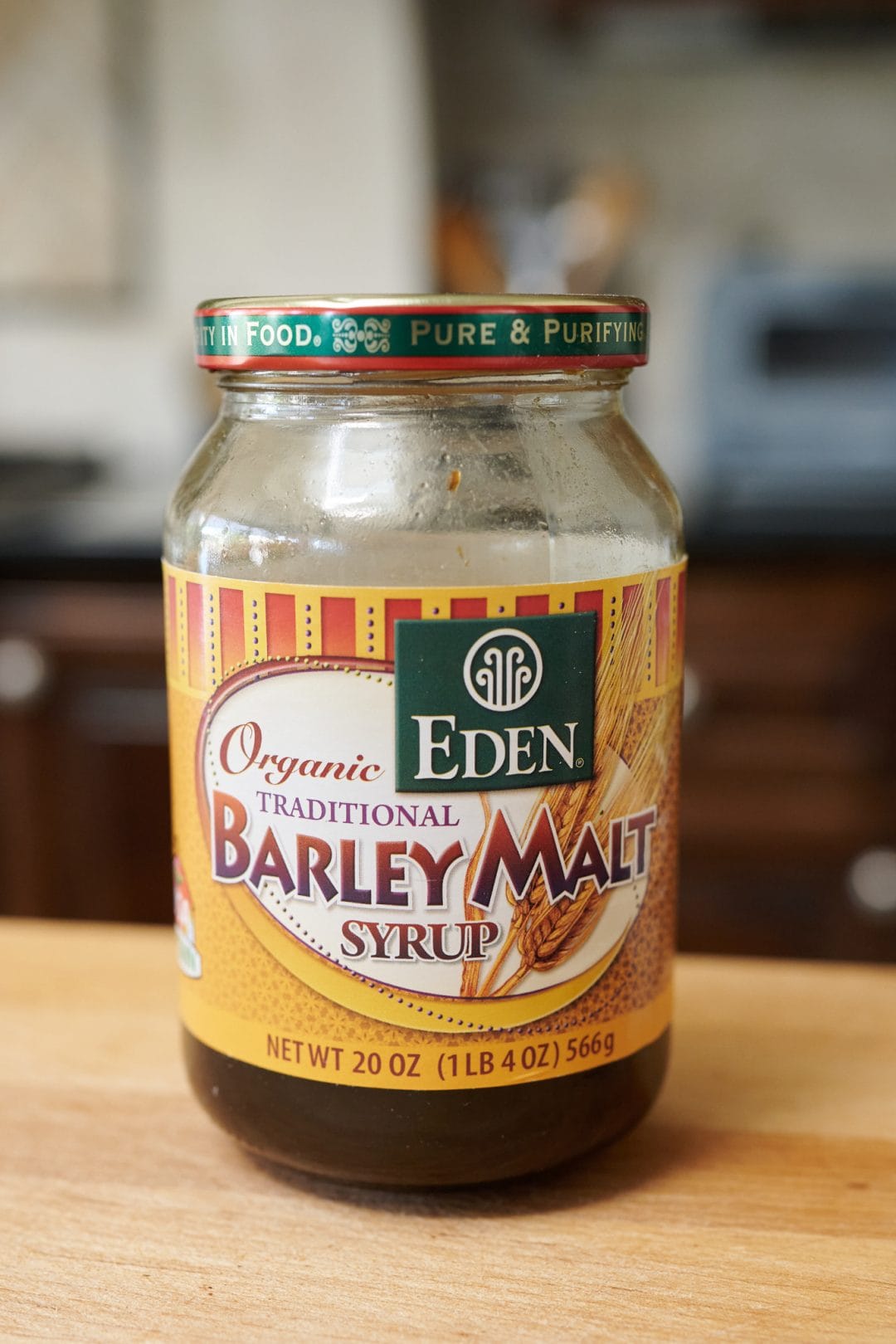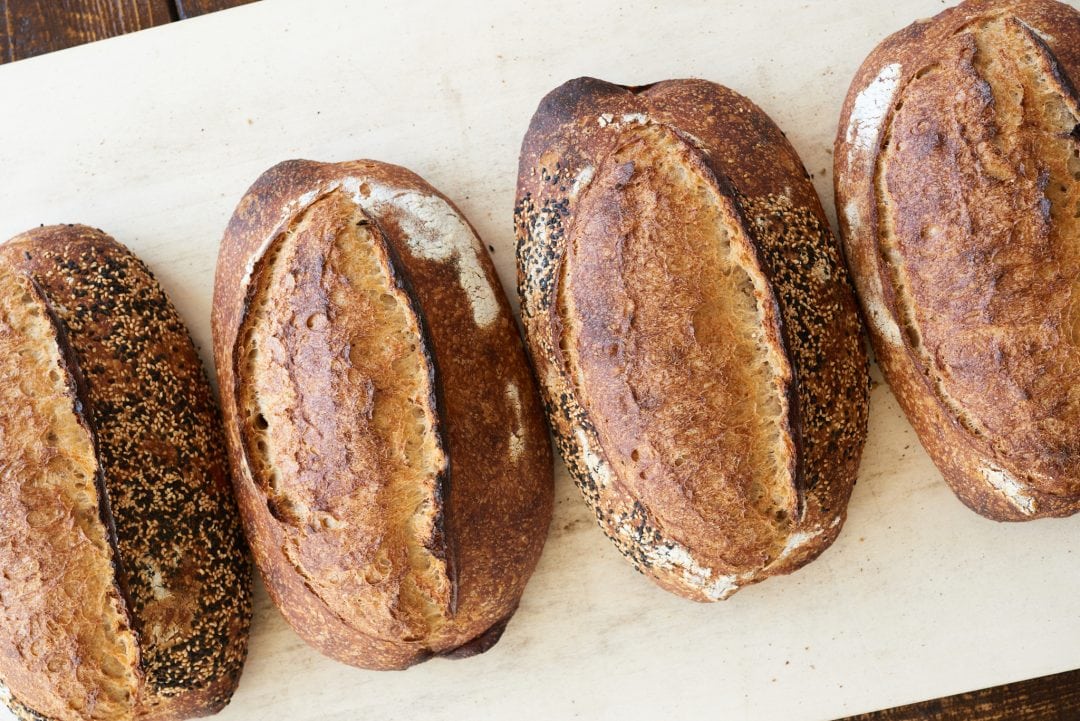With this post, we welcome Rebecca Firkser to The Perfect Loaf. Rebecca is a writer (currently working on her first cookbook!), editor, and recipe developer who has worked at Epicurious, Bon Appetit, NYT Cooking, Food52, and more.
Using diastatic malt powder in yeasted baked goods can make a huge difference in their rise, color, and texture. Though many people may associate the term “malt” with milk balls or 40-ounce bottles of liquor, diastatic malt powder can be an extremely valuable ingredient to bakers. The enzymatically active ingredient is especially important for those who work with long-fermented sourdough-based doughs and organic, whole-wheat, and home-milled flours. Made from sprouted grain, typically barley, diastatic malt powder aids in the color, flavor, and texture of yeasted doughs.
At a Glance, Diastatic Malt Powder:
- Is also known as “diastatic malt flour”
- Is made from sprouted grain, typically barley or wheat
- Contains diastase enzymes, which break down starches into simpler carbohydrates
- Aids in the browning of crust, as well as the sweetness of yeasted bakes
- Acts as a food for yeast, which can aid in oven spring, yielding a loftier loaf or roll; as well as a more tender, even crumb
- Is useful when baking with many organic, whole-wheat, and home-milled flours, which do not contain added barley malt
- Can be characterized as a “dough conditioner”
- Is not the same as non-diastatic malt powder
- Should be used in very small amounts to avoid an overly red dough or rubbery crumb
What Is Malt?
Malt is a byproduct of cereal grains, most often barley, by allowing for partial germination of the grain. Wheat, corn, rye, and rice can be malted, but barley malt products are most widely available.
Malt is largely used in the production of beer, as well as whiskey and malt liquor. Malt can be found in a syrup or powdered form. It’s also often used as an nutritional and technical enhancer to ingredients and food products like non-organic flours, vinegars, breakfast cereals, and powdered milk-based beverages.

What Is Diastatic Malt?
Diastatic malt is a type of malt made from sprouted grain, typically barley or wheat. As the name suggests, it contains diastase enzymes (the common name for alpha-amylase and beta-amylase), which break down starches into subcategories of carbohydrates. Diastase enzymes first break down starches into dextrins and, importantly, maltose, a disaccharide known as malt sugar. Then, these enzymes work to further break down the dextrins (and other polysaccharides) into dextrose, a monosaccharide that is easily metabolized by yeasts.
Many commercial all-purpose or high-protein bread flours contain added barley malt (or “malted barley flour,” or “enzymes,” all of which are the same base ingredient), omitting the need for diastatic malt as an isolated ingredient in baking. However, many organic, whole-wheat, and home-milled flours do not contain additives, meaning doughs made with this can benefit from added malt.
Diastatic malt is commercially available as a syrup, powder or flour, and extract. When used in baking it increases the enzymatic activity of dough, which means starch converts to sugar more quickly. As a result, the sugars caramelize more intensely, making a darker crust and a sweeter dough. As a result of heightened yeast activity, malt can help bakes rise into a higher volume, with a more tender and even texture.

What Is Diastatic Malt Powder?
Diastatic malt powder is also known as diastatic malt flour. Making diastatic malt powder is a multi-step process. First, grain kernels are first soaked in water, which increases metabolic activity and keeps the grain hydrated. The kernels are drained and covered, then left to germinate for several days until they form sprouts. The sprouted kernels are fully dried (in a dehydrator or oven) at a low temperature to maintain enzymatic activity, and then milled into a size comparable to particles of wheat flour.

What Is The Best Diastatic Malt Powder?
Breadtopia’s Malted Barley Flour is an excellent choice and comes in small bags perfect for the home baker. Alternatively, I also like King Arthur Baking’s Diastatic Malt Powder.
When Should I Use Diastatic Malt Powder In Baking?
Considering using diastatic malt when:
- Using primarily white flour without malt
- Fermentation is slow
- There are long fermentation times
- The crust lacks color, unrelated to steam, temperature, or overproofing
Test by adding a small amount of malt to a bake and observe the results. Start at 0.25% of the total flour weight in baker’s percentages. Adjust gradually through testing, staying between 0.25% and 1%.
What Is The Difference Between Diastatic Malt Powder And Non-Diastatic Malt Powder?
As established, diastatic malt powder contains active diastase enzymes, which help convert more starch to sugar. It’s especially effective in doughs with a long fermentation time, and will impart more caramelization to the bake, yielding a deeper color and sweeter flavor.

Non-diastatic malt powder, also known as simply “malt flour,” on the other hand, is not enzymatically active. It must be dried, or kilned, at a higher temperature in order to remove enzymatic activity, and will not affect yeasted doughs exactly like its counterpart. Used more exclusively for imparting a nutty-sweet flavor and deeper color to bakes, non-diastatic malt powder does not aid in oven spring.
Non-diastatic and diastatic malt powders are not interchangeable. If diastatic malt powder is used in place of non-diastatic, it can result in a reddish, gummy-textured bake. If you only have diastatic malt powder, but need non-diastatic, King Arthur Baking recommends spreading the diastatic malt powder on a sheet pan and baking at 350°F for 5 minutes.
Read more about malt—and learn how to make your own non-diastatic malt powder— here.
Is Diastatic Malt A Dough Conditioner?
Dough conditioner is largely defined as any addition to dough that improves the consistency of the bake; essentially, any ingredient added to serve this purpose besides flour, yeast, and water can be called a dough conditioner. There are commercial dough enhancer powders (consisting of enzymes and emulsifiers, as well as reducing agents like L-cysteine to improve dough extensibility and anti-oxidants like ascorbic acid (Vitamin C at NIH) to strengthen dough). But natural ingredients like sugar or honey, eggs, and ginger can also offer similar improvements to various dough elements.
As it promotes yeast growth, improves the crumb, and helps to ensure the consistency of yeasted bakes, diastatic malt powder can be characterized as a dough conditioner.
What is Malted Milk Powder?
Malted milk powder is a light yellow powder made from dehydrated malted barley, wheat flour, and evaporated milk. The grains offer a toasty-earthy flavor while the milk lends richness. Malted milk powder also contains baking soda and salt for savory flavor, and sometimes sugar for sweetness.
Like non-diastatic malt powder, malted milk powder is not enzymatically active and doesn’t affect technical components of yeasted doughs (though it’s not interchangeable with non-diastatic malt powder in baking). It’s used purely as flavoring, be it in powdered milk beverages like Milo and Ovaltine, or in a malted milk ball or milkshake.
Diastatic Malt Powder FAQs
What is your favorite diastatic malt powder?
Breadtopia’s Malted Barley Flour is home-kitchen friendly, as it’s affordable and comes in easy-to-store 8-ounce packages.
How do I know how much diastatic malt powder to use in a recipe?
Diastatic malt powder should be used in very small amounts. Packaged versions will suggest ratios for their specific formula. (For example, per 3 cups of flour, Breadtopia recommends ½ teaspoon diastatic malt powder; King Arthur recommends ½ to 1 teaspoon.) In general, Maurizio recommends starting with a range of about 0.25% to 1% of the total weight of the flour.
Can I substitute diastatic malt powder for non-diastatic malt powder?
Non-diastatic malt powder should not be used as a substitute for diastatic malt powder, and vice-versa. If non-diastatic malt powder is used in place of diastatic, the lack of enzymatic activity can compromise proper fermentation and oven spring; using diastatic instead of non-diastatic can result in a red color and gummy texture.
Is diastatic malt powder the same as diastatic malt flour?
Yes, diastatic malt powder and diastatic malt flour are interchangeable terms. The ingredient can also be labeled as “malted barley flour” or “barley malt.”
Do commercial flours contain diastatic malt?
Many commercial brands of flour, especially all-purpose, contain diastatic malt. Commercial whole-wheat flour does not tend to contain diastatic malt. Some organic flours will contain diastatic malt, and others will not. If you’re not certain, check the ingredients list.
Does diastatic malt go bad?
Yes, because diastatic malt has active enzymes, they will degrade over time. Typically, it’s best to use it within 12 months of purchasing. Usually, the best-by date will be printed on the package.
What is the best way to store diastatic malt?
Keep diastatic malt in an airtight container in a dry and cool place out of direct sunlight. If it becomes excessively hot or moist, it can compromise enzymatic activity.
What’s Next?
If you’re looking to get more comfortable using malt in baking, start with Maurizio’s Malted Wheat Sourdough, which uses DIY non-diastatic malt flour as a flavor enhancer.
From there, move onto The Perfect Loaf x Hayden Flour Mills loaf, which calls for an optional addition of diastatic malt; or Sourdough Bagels, which use diastatic malt for the enzymatic properties and barley malt syrup as a sweetener.





